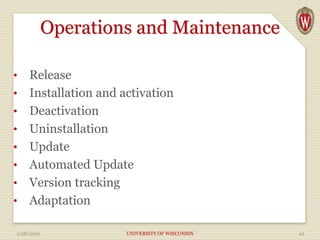Software Development Methodologies
- 1. Information Systems 371 Lecture 3, January 29, 2019 Topic: Software Development Methodologies Lecturer: Nicholas Davis
- 2. Let’s Start With Some Humor Related to RAD (Rapid Application Development) 1/28/2019 UNIVERSITY OF WISCONSIN 2
- 3. Housekeeping • Did everyone get the email I sent on Monday? If not, please write down your email address and give it to me at the end of class • Is the installation of Visual Studio going OK • Programming assignments: What is the best way to learn? How do we avoid having anyone left behind? • Is class going OK? Would you tell me if it wasn’t. I don’t want to learn about it at the end of the semester • How about a visit from Epic? 1/28/2019 UNIVERSITY OF WISCONSIN 3
- 4. Interesting Article Does Hardware Even Matter Anymore? • https://hbr.org/2015/06/does- hardware-even-matter-anymore • Are you a hardware person or a software person? • Which areas of information systems interest you most, and where do you envision the biggest opportunities? 1/28/2019 UNIVERSITY OF WISCONSIN 4
- 5. You Don’t Just “Program”, You “Develop Software” • In software engineering, a software development process is the process of dividing software development work into distinct phases to improve design, product management, and project management 1/28/2019 UNIVERSITY OF WISCONSIN 5
- 6. Software Development • Most modern development processes can be vaguely described as agile. Other methodologies include waterfall, prototyping, iterative and incremental development, spiral development, rapid application development, and extreme programming. 1/28/2019 UNIVERSITY OF WISCONSIN 6
- 7. Agile Software Development • Agile software development describes an approach to software development under which requirements and solutions evolve through the collaborative effort of self- organizing cross-functional teams and their customer/end users • It advocates adaptive planning, evolutionary development, early delivery, and continuous improvement, and it encourages rapid and flexible response to change 1/28/2019 UNIVERSITY OF WISCONSIN 7
- 8. “Pair Programming” in Agile Development 1/28/2019 UNIVERSITY OF WISCONSIN 8
- 9. Waterfall (Old School) Software Development 1. System and software requirements: captured in a product requirements document 2. Analysis: resulting in models, schema, and business rules 3. Design: resulting in the software architecture 4. Coding: the development, proving, and integration of software 5. Testing: the systematic discovery and debugging of defects 6. Operations: the installation, migration, support, and maintenance of complete systems 1/28/2019 UNIVERSITY OF WISCONSIN 9
- 10. Waterfall Usually Has 5 or 6 Steps 1/28/2019 UNIVERSITY OF WISCONSIN 10
- 11. Prototyping Software Development Software prototyping is the activity of creating prototypes of software applications, i.e., incomplete versions of the software program being developed. It is an activity that can occur in software development and is comparable to prototyping as known from other fields, such as mechanical engineering or manufacturing. A prototype typically simulates only a few aspects of, and may be completely different from, the final product. 1/28/2019 UNIVERSITY OF WISCONSIN 11
- 12. Prototyping 1/28/2019 UNIVERSITY OF WISCONSIN 12
- 13. Iterative Software Development • Worst definition EVER: Relating to or involving iteration, especially of a mathematical or computational process. • You start by writing a general application, but then come back to it to add a few more features at a time, over and over, evolving over time 1/28/2019 UNIVERSITY OF WISCONSIN 13
- 14. Iterative Software Development 1/28/2019 UNIVERSITY OF WISCONSIN 14
- 15. Spiral Software Development Don’t even bother learning about this. It is rarely used, and overly complex. Forget about it! 1/28/2019 UNIVERSITY OF WISCONSIN 15
- 16. Rapid Application Development • RAD approaches to software development put less emphasis on planning and more emphasis on an adaptive process. Prototypes are often used in addition to or sometimes even in place of design specifications. • RAD is especially well suited for (although not limited to) developing software that is driven by user interface requirements. Graphical user interface builders are often called rapid application development tools. 1/28/2019 UNIVERSITY OF WISCONSIN 16
- 17. Extreme Software Development • A flat management structure, code simplicity and clarity, expecting changes in the customer's requirements as time passes and the problem is better understood, and frequent communication with the customer and among programmers 1/28/2019 UNIVERSITY OF WISCONSIN 17
- 18. Extreme Programming 1/28/2019 UNIVERSITY OF WISCONSIN 18
- 19. Software Development Life Cycle (SDLC) • The systems development life cycle (SDLC), also referred to as the application development life- cycle, is a term used in systems engineering, information systems and software engineering to describe a process for planning, creating, testing, and deploying an information system. • Uses an enhanced Waterfall methodology • Talk about it at a job interview to sound smart and eat up a bunch of time! 1/28/2019 UNIVERSITY OF WISCONSIN 19
- 20. SDLC 8 Phases 1. System investigation 2. System analysis 3. Design 4. Environments 5. Testing 6. Training and transition 7. Operations and maintenance 8. Evaluation 1/28/2019 UNIVERSITY OF WISCONSIN 20
- 21. SDLC System Investigation • The system investigates the IT proposal. During this step, we must consider all current priorities that would be affected and how they should be handled. Before any system planning is done, a feasibility study should be conducted to determine if creating a new or improved system is a viable solution. This will help to determine the costs, benefits, resource requirements, and specific user needs required for completion. The development process can only continue once management approves of the recommendations from the feasibility study. • Following are different components of the feasibility study: • Operational feasibility • Economic feasibility • Technical feasibility • Human factors feasibility • Legal/Political feasibility 1/28/2019 UNIVERSITY OF WISCONSIN 21
- 22. SDLC Systems Analysis • The goal of system analysis is to determine where the problem is, in an attempt to fix the system. This step involves breaking down the system in different pieces to analyze the situation, analyzing project goals, breaking down what needs to be created and attempting to engage users so that definite requirements can be defined. 1/28/2019 UNIVERSITY OF WISCONSIN 22
- 23. SDLC Design • Describes desired features and operations in detail, including screen layouts, business rules, process diagrams, pseudocode and other documentation. 1/28/2019 UNIVERSITY OF WISCONSIN 23
- 24. SDLC Development • Environments are controlled areas where systems developers can build, distribute, install, configure, test, and execute systems that move through the SDLC. Each environment is aligned with different areas of the SDLC and is intended to have specific purposes. Examples of such environments follow on the next slide. 1/28/2019 UNIVERSITY OF WISCONSIN 24
- 25. SDLC Development • Development environment, where developers can work independently of each other before trying to merge their work with the work of others, • Common build environment, where merged work can be built, together, as a combined system, • Systems integration testing environment, where basic testing of a system's integration points to other upstream or downstream systems can be tested, • User acceptance testing environment, where business stakeholders can test against their original business requirements, • Production environment, where systems finally get deployed to, for final use by their intended end users. 1/28/2019 UNIVERSITY OF WISCONSIN 25
- 26. Do You Know the Dos Equis Guy? “I don’t always drink beer, but when I do, I choose Dos Equis” 1/28/2019 UNIVERSITY OF WISCONSIN 26
- 27. In a Previous Life, He Was a Software Developer, But Got Fired 1/28/2019 UNIVERSITY OF WISCONSIN 27
- 28. SDLC Testing • The code is tested at various levels in software testing. Unit, system and user acceptance testings are often performed. This is a grey area as many different opinions exist as to what the stages of testing are 1/28/2019 UNIVERSITY OF WISCONSIN 28
- 29. So Much Testing in the SDLC • Path testing • Data set testing • Unit testing • Integration testing • System testing • Black-box testing • White-box testing • Regression testing • Automation testing • User acceptance testing • Software performance testing 1/28/2019 UNIVERSITY OF WISCONSIN 29
- 30. Path Testing • Does data move through the system in the manner you expect? 1/28/2019 UNIVERSITY OF WISCONSIN 30
- 31. Data Set Testing • Test data is data which has been specifically identified for use in tests, typically of a computer program. • Some data may be used in a confirmatory way, typically to verify that a given set of input to a given function produces some expected result. Other data may be used in order to challenge the ability of the program to respond to unusual, extreme, exceptional, or unexpected input. 1/28/2019 UNIVERSITY OF WISCONSIN 31
- 32. Unit Testing • Is a software testing method by which individual units of source code, sets of one or more computer program modules together with associated control data, usage procedures, and operating procedures, are tested to determine whether they are fit for us 1/28/2019 UNIVERSITY OF WISCONSIN 32
- 33. Integration Testing • Is the phase in software testing in which individual software modules are combined and tested as a group. It occurs after unit testing and before 1/28/2019 UNIVERSITY OF WISCONSIN 33
- 34. System Testing System testing of software or hardware is testing conducted on a complete, integrated system to evaluate the system's compliance with its specified requirements. 1/28/2019 UNIVERSITY OF WISCONSIN 34
- 35. Black Box Testing • You put something you know, into the system. You expect to get a certain result. Does that result match what you were expecting? You ONLY look at the output, not what happens within each step of the application • There are benefits and drawbacks to Black Box Testing 1/28/2019 UNIVERSITY OF WISCONSIN 35
- 36. White Box Testing • White-box testing (also known as clear box testing, glass box testing, transparent box testing, and structural testing) is a method of testing software that tests internal structures or workings of an application, as opposed to its functionality (i.e. black-box testing). In white-box testing an internal perspective of the system, as well as programming skills, are used to design test cases 1/28/2019 UNIVERSITY OF WISCONSIN 36
- 37. Regression Testing • Is a type of software testing which verifies that software which was previously developed and tested still performs the same way after it was changed or interfaced with other software. Changes may include software enhancements, patches, configuration changes, etc. During regression testing, new software bugs or regressions may be uncovered. 1/28/2019 UNIVERSITY OF WISCONSIN 37
- 38. Test Automation • Is the use of special software (separate from the software being tested) to control the execution of tests and the comparison of actual outcomes with predicted outcomes.[1] Test automation can automate some repetitive but necessary tasks in a formalized testing process already in place, or perform additional testing that would be difficult to do manually. 1/28/2019 UNIVERSITY OF WISCONSIN 38
- 39. User Acceptance Testing • UAT consists of a process of verifying that a solution works for the user. It is not system testing (ensuring software does not crash and meets documented requirements), but rather ensures that the solution will work for the user (i.e., tests that the user accepts the solution); software vendors often refer to this as "Beta testing". 1/28/2019 UNIVERSITY OF WISCONSIN 39
- 40. Software Performance Testing • Is in general, a testing practice performed to determine how a system performs in terms of responsiveness and stability under a particular workload. It can also serve to investigate, measure, validate or verify other quality attributes of the system, such as scalability, reliability and resource usage. 1/28/2019 UNIVERSITY OF WISCONSIN 40
- 41. SDLC Training and Transition • Once a system has been stabilized through adequate testing, the SDLC ensures that proper training on the system is performed or documented before transitioning the system to its support staff and end users. • Training usually covers operational training for those people who will be responsible for supporting the system as well as training for those end users who will be using the system after its delivery to a production operating environment. 1/28/2019 UNIVERSITY OF WISCONSIN 41
- 42. Operations and Maintenance • Release • Installation and activation • Deactivation • Uninstallation • Update • Automated Update • Version tracking • Adaptation 1/28/2019 UNIVERSITY OF WISCONSIN 42
- 43. SDLC Evaluation • The final phase of the SDLC is to measure the effectiveness of the system and evaluate potential enhancements. 1/28/2019 UNIVERSITY OF WISCONSIN 43
- 44. Strengths and Weaknesses of SDLC 1/28/2019 UNIVERSITY OF WISCONSIN 44 Strengths Weaknesses Control Increased development time Monitor large projects Increased development cost Detailed steps Systems must be defined up front Evaluate costs and completion targets Rigidity Documentation Hard to estimate costs, project overruns Well defined user input User input is sometimes limited Ease of maintenance Development and design standards Tolerates changes in MIS staffing
- 45. 1/28/2019 UNIVERSITY OF WISCONSIN 45




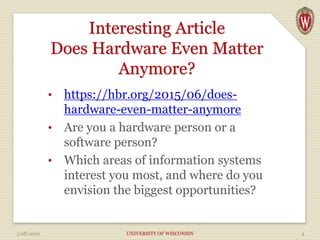




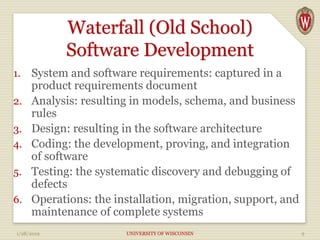

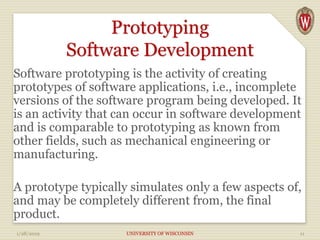


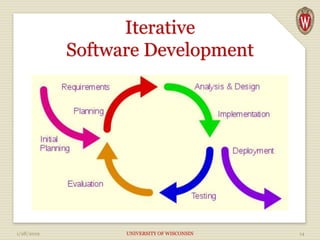























![Test Automation
• Is the use of special software (separate from the
software being tested) to control the execution of
tests and the comparison of actual outcomes with
predicted outcomes.[1] Test automation can
automate some repetitive but necessary tasks in a
formalized testing process already in place, or
perform additional testing that would be difficult
to do manually.
1/28/2019 UNIVERSITY OF WISCONSIN 38](https://image.slidesharecdn.com/lecture3-190128233642/85/Software-Development-Methodologies-38-320.jpg)



